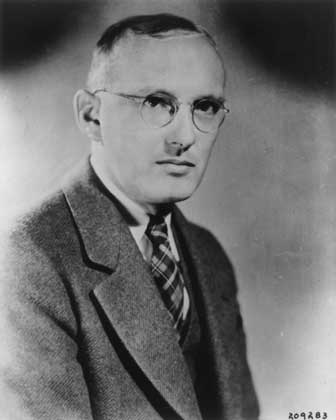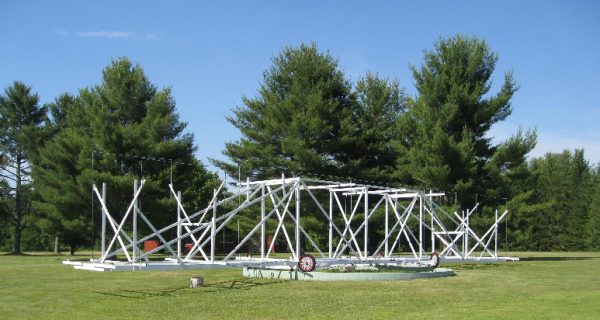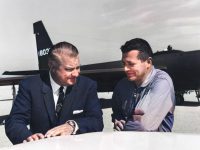
Karl Guthe Jansky (1905-1950)
On October 22, 1905, American physicist and radio engineer Karl Guthe Jansky was born. In August 1931 Jansky first discovered radio waves emanating from the Milky Way. He is considered one of the founding figures of radio astronomy.
Karl Jansky – Background
Karl Jansky was born the third of six children in what was then the Territory of Oklahoma where his father, Cyril M. Jansky, the descendent of Czech immigrants, was Dean of the College of Engineering at the University of Oklahoma at Norman. He was an engineer with a strong interest in physics, a trait passed on to his sons. Karl Jansky attended college at the University of Wisconsin–Madison where he received his BS in physics in 1927. He stayed an extra year at Madison, completing all the graduate course work for a Masters degree in physics except for the thesis. In 1928 he joined the Bell Telephone Laboratories in Holmdel, New Jersey.
Looking for Electromagnetic Interferences
Bell Labs wanted to investigate atmospheric and ionospheric properties using “short waves“, i.e. electromagnetic waves with wavelengths of about 10–20 meters, for use in transatlantic radio telephone service. Although transatlantic radio communication was possible in the early 1930s, it was very expensive and poor in quality. It cost 75 dollars to talk for three minutes from New York to London, and the transmissions, which occurred not through cables but through radio waves, were routinely interrupted by static withe clicking, banging, crackling, and hissing noises that sometimes obliterated the conversation.[2] As a Bell radio engineer, Jansky was assigned the job of investigating sources of static that might interfere with radio voice transmissions. Holmdel was chosen for the experiments as being a rural area where there would be very little interference from man-made radio signals.
The Antenna
At Bell Telephone Laboratories Jansky built an antenna designed to receive radio waves at a frequency of 20.5 MHz (wavelength about 14.6 meters). It was mounted on a turntable that allowed it to be rotated in any direction, earning it the name “Jansky’s merry-go-round“. It had a diameter of approximately 30 meters. By rotating the antenna on a set of four Ford Model-T tires, the direction of a received signal could be pinpointed. A small shed to the side of the antenna housed an analog pen-and-paper recording system.
“…a faint steady hiss of unknown origin”
After recording signals from all directions for several months, Jansky eventually categorized them into three types of static: nearby thunderstorms, distant thunderstorms, and a faint steady hiss of unknown origin. He spent over a year investigating the source of the third type of static. The location of maximum intensity rose and fell once a day, leading Jansky to initially surmise that he was detecting radiation from the Sun. After a few months of following the signal, however, the brightest point moved away from the position of the Sun. Jansky also determined that the signal repeated on a cycle of 23 hours and 56 minutes, the period of the Earth’s rotation relative to the stars (sidereal day), instead of relative to the sun (solar day). By comparing his observations with optical astronomical maps, Jansky concluded that the radiation was coming from the Milky Way and was strongest in the direction of the center of the galaxy, in the constellation of Sagittarius. Jansky was also fortunate in another respect, because his investigations were conducted at a time when the 11-year cycle of solar activity was at a minimum, which rendered the ionosphere transparent to 20 MHz wavelengths at night. If this had not been the case, solar flares would have drowned out the weak hisses from space, and Jansky would never have been able to measure them.[2]
Electrical disturbances apparently of extraterrestrial origin
His discovery was widely publicized, appearing in the New York Times of May 5, 1933, followed by his paper “Electrical disturbances apparently of extraterrestrial origin“. Jansky also reasoned that the emissions from space would be found all along the electromagnetic spectrum, a hypothesis confirmed by later researchers. He wanted to follow up on this discovery and investigate the radio waves from the Milky Way in further detail. He submitted a proposal to Bell Labs to build a 30 meter diameter dish antenna with greater sensitivity that would allow more careful measurements of the structure and strength of the radio emission. Bell Labs, however, rejected his request for funding on the grounds that the detected emission would not significantly affect their planned transatlantic communications system. Jansky was re-assigned to another project and did no further work in the field of astronomy.

Full-size replica of the first radio telescope, built by Karl Jansky and now at the National Radio Astronomical Observatory (NRAO) in Green Bank, West Virginia
The Beginnings of Radio Astronomy
Many scientists were fascinated by Jansky’s discovery, but no one followed up on it for several years. It was during the great depression, and observatories could not afford take on any new projects.[1] Moreover, radio astronomy remained a dormant field for several years, due in part to Jansky’s lack of formal training as an astronomer. Two men who learned of Jansky’s 1933 discovery were of great influence on the later development of the new study of radio astronomy: one was Grote Reber,[6] a radio engineer who singlehandedly built a radio telescope in his Illinois back yard in 1937 and did the first systematic survey of astronomical radio waves. The second was Prof. John D. Kraus, who, after World War II, started a radio observatory at Ohio State University and wrote a textbook on radio astronomy, long considered a standard by radio astronomers.
Further Contributions
Jansky made other contributions to the understanding of radio communications while he worked at Bell. He became adept at detecting the direction of arrival of short-wave transmissions from all over the globe, which led to a better understanding of the effects of radio propagation. The information Jansky gained helped refine the design of both transmitting and receiving antennas. He also conducted research on noise reduction in receivers and other circuits. In honor of Jansky, the unit used by radio astronomers for the strength (or flux density) of radio sources is the jansky (1 Jy = 10−26 W m−2 Hz−1). Jansky noise is named after Jansky, and refers to high frequency static disturbances of cosmic origin.
Karl Jansky died on February 14, 1950, in Red Bank, New Jersey, USA, due to a heart condition at age 44.
Woody Sullivan, “The Beginnings of Radio Astronomy around the World”, [5]
References and Further Reading:
- [1] Karl Jansky and the Discovery of Cosmic Radio Waves, at National Radio Astronomy Observatory
- [2] “Jansky, Karl.” World Encyclopedia. . Encyclopedia.com
- [3] Detective Work Leads to Monument Honoring the Father of Radio Astronomy, Nokia Bell Labs, 1998.
- [4] Karl Jansky, American engineer, at Britannica Online
- [5] Woody Sullivan, “The Beginnings of Radio Astronomy around the World”, Canadian Radio Astronomy History @ youtube
- [6] Grote Reber – Pioneer of Radio Astronomy, SciHi Blog
- [7] Jansky, Karl Guthe (December 1933). “Electrical phenomena that apparently are of interstellar origin”. Popular Astronomy. 41: 548.
- [8] Jansky, Karl Guthe (October 1935). “A note on the source of interstellar interference”. Proc. IRE. 23 (10): 1158.
- [9] Kraus, John (Fall 1981). “The First 50 Years of Radio Astronomy, Part 1: Karl Jansky and His Discovery of Radio Waves from Our Galaxy”. North American AstroPhysical Observatory (NAAPO). Cosmic Search, Vol. 3, No. 4.
- [10] Sullivan, W. T. (2009), Cosmic Noise: A History of Early Radio Astronomy, Cambridge University Press.
- [11] Karl Jansky at Wikidata
- [12] Timeline of Radio Astronomers, via Wikidata and DBpedia






Pingback: Whewell’s Gazette: Year 3, Vol. #10 | Whewell's Ghost